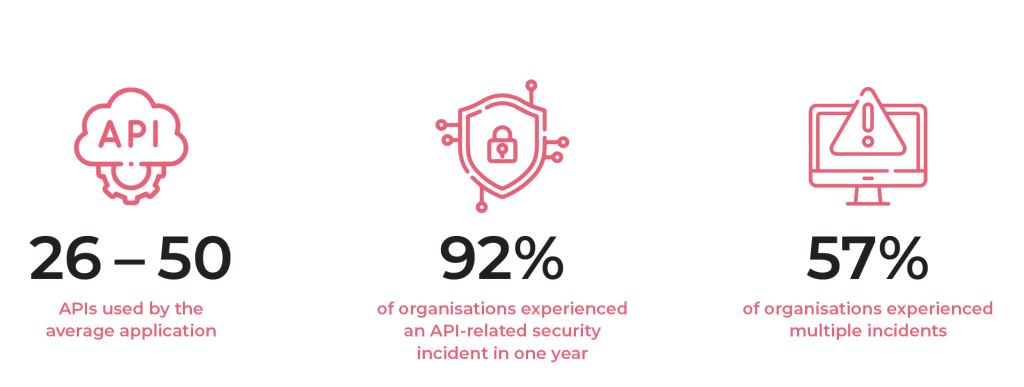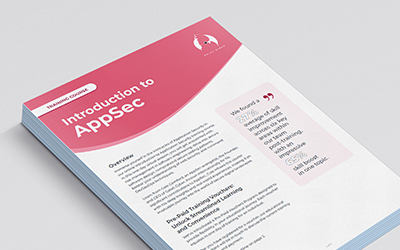Application Programming Interfaces (APIs) support modern web and mobile applications by enabling seamless communication between systems. A report by Palo Alto Networks found that the average application uses between 26 and 50 APIs. This report also highlighted the security concerns overshadowing APIs. Despite deploying multiple security products, 92% of organisations experienced an API-related security incident in one year, with 57% facing multiple breaches.
If improperly managed, APIs can create many vulnerabilities within your business. This guide covers the top API security threats in 2024 and strategies to protect APIs.

Source: Palo Alto Networks.
Why do cybercriminals target APIs?
Attackers often focus on APIs because they offer a direct path to critical applications and sensitive data. APIs give threat actors multiple points of entry because they handle numerous requests and responses. Each API endpoint could reveal a weakness a threat actor can exploit due to inadequate access controls, improper validation, or insufficient monitoring. Given the complexity and extensive usage of APIs, even a single vulnerability can provide an entry point for attackers.
APIs often handle Personally Identifiable Information (PII) and other sensitive data, which makes them high-value targets for data breaches. Cybercriminals exploit APIs to access user data, financial information, and other confidential resources. Their interconnected nature means that a vulnerability in one API can compromise multiple applications and systems, leading to widespread damage. As more industries – such as banking and healthcare – use APIs, the stakes have increased.

What are the top threats to API security?
The following list is a handful of the top API security threats:
Distributed Denial of Service (DDoS) attacks
A survey by Traceable found that ‘DDoS attacks stand out as the predominant API attack method resulting in a breach, with 38% of respondents confirming this.’ DDoS attacks render an API unusable by flooding it with requests. They cause service disruptions by exploiting APIs that do not have resource consumption limits. Rate limiting and DDoS mitigation strategies prevent these attacks.
Exploitable vulnerabilities
Vulnerability exploits occur when attackers identify API design or implementation flaws, such as broken object-level authorisation or improper input validation. These vulnerabilities give threat actors unintended access to an API or its corresponding application. The OWASP Top 10 API Security Risks list for 2023 summarises the key vulnerabilities. Proper coding practices and regular security assessments help identify and mitigate these vulnerabilities before a threat actor can exploit them.
Third-party APIs
APIs often rely on third-party services to enhance functionality. Developers might trust data received from third-party APIs without applying the same security standards as they would to user input. An oversight like this leads to potential data leaks and compromised APIs. Mitigate these risks by evaluating third-party APIs before use to ensure they meet security standards.
Exploited authentication tokens
Authentication measures ensure that API requests come from legitimate sources. However, attackers can compromise authentication tokens through credential stuffing or exploiting flaws to impersonate users. To mitigate these risks, it is essential to implement secure token management practices. This includes monitoring token usage, analysing refresh token patterns for anomalies, and expiring tokens regularly based on the level of access granted. Limit the actions a particular token can perform to further prevent abuse. Regularly auditing authentication processes is also crucial to identify and rectify potential vulnerabilities.
Security misconfigurations
APIs and their supporting systems often have complex configurations, which, if managed incorrectly, can lead to security misconfigurations. These misconfigurations can lead to various attacks, including unauthorised access and data leaks. Common issues include incorrect authentication and authorisation settings and exposed sensitive data. Regularly reviewing and updating configurations, applying security best practices, and automating configuration management can improve API security.

Preventing API security threats
Now that you understand the key API security threats, here are some measures you can take to minimise the risks:
Heuristics to understand existing behaviour
Heuristics in API security are principles or strategies used to identify and analyse potential security issues. Teams can adapt testing methods to specific contexts and ensure comprehensive coverage and problem detection. By applying heuristics, teams can pinpoint vulnerabilities, understand API behaviour, and make informed decisions about security measures.
Use contract and schema validation
Schema validation ensures incoming requests conform to the expected formats and blocks malicious requests that do not comply with the schema. Enforcing contract and schema validation helps maintain the integrity of APIs by preventing invalid requests that might warp how the API behaves.
Enforce tokens and limit their access
Authentication and authorisation measures prevent API security attacks. Controls include API keys or OAuth tokens to verify someone’s identity and their level of authorisation when using the API. Limiting what a token can access will also reduce risks. These should be standard practices to minimise unauthorised access. Regularly review and update your controls to prevent vulnerabilities.
Implement rate limiting and Web Application Firewalls (WAFs)
Rate limiting and WAFs are out of band controls to prevent DDoS. Rate limiting restricts the requests a client can make within a specified timeframe. Enforcing this prevents API abuse and reduces the impact of DoS and DDoS attacks by ensuring the API service remains available to legitimate users. A WAF monitors HTTP traffic and blocks malicious requests based on predefined rules. WAFs filter out harmful traffic before it reaches the API to prevent attacks such as SQL injection, cross-site scripting (XSS), and other common web application vulnerabilities.
Conduct regular security audits and penetration testing
Regular security assessments and penetration tests enable your team to identify and fix vulnerabilities before threat actors can exploit them. Proactive measures like this help maintain the security posture by addressing potential weaknesses in API security.

Conclusion
Securing APIs against threat actors is critical to protecting your applications, customers, and business. Cybercriminals often target APIs because they are easy targets responsible for transmitting sensitive data and PII, which becomes a lucrative resource when sold online.
Developers should understand the top API security threats and implement best practices to prevent them. By adopting strong authentication and authorisation measures, enforcing schema validation, deploying web application firewalls, applying rate limiting, and conducting regular security audits, developers can significantly enhance API security.
Why choose Galah Cyber to improve API security?
Our team at Galah Cyber helps prevent API security threats through comprehensive security assessments. We identify vulnerabilities and provide expert recommendations to ensure a secure API ecosystem tailored to your organisation’s needs.
APIs are essential for modern applications, but they also present significant security challenges. With the increasing frequency of API-related breaches, organisations must prioritise API security to protect sensitive data and maintain customer trust.
By implementing robust security measures, such as authentication, authorization, and regular security audits, you can significantly reduce the risk of attacks. Our experts can help you assess your API security posture and develop a tailored protection plan. Contact us today to learn how our API security solutions can safeguard your business.
In addition to API security assessments, we offer cybersecurity engineering, DevSecOps enablement, and secure code reviews. Visit our Assurance Services page for more information and to get in touch.







